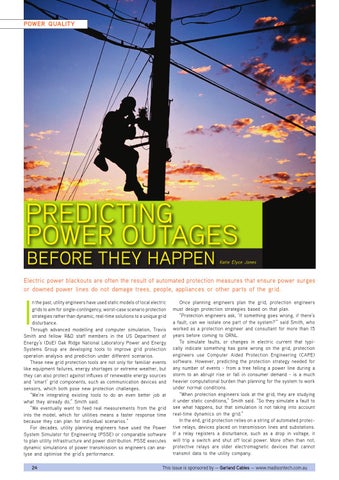POWER XXXXXXXXXXXXX QUALITY
PREDICTING POWER OUTAGES BEFORE THEY HAPPEN
Katie Elyce Jones
Electric power blackouts are often the result of automated protection measures that ensure power surges or downed power lines do not damage trees, people, appliances or other parts of the grid.
I
n the past, utility engineers have used static models of local electric grids to aim for single-contingency, worst-case scenario protection strategies rather than dynamic, real-time solutions to a unique grid disturbance. Through advanced modelling and computer simulation, Travis Smith and fellow R&D staff members in the US Department of Energy’s (DoE) Oak Ridge National Laboratory Power and Energy Systems Group are developing tools to improve grid protection operation analysis and prediction under different scenarios. These new grid protection tools are not only for familiar events like equipment failures, energy shortages or extreme weather, but they can also protect against influxes of renewable energy sources and ‘smart’ grid components, such as communication devices and sensors, which both pose new protection challenges. “We’re integrating existing tools to do an even better job at what they already do,” Smith said. “We eventually want to feed real measurements from the grid into the model, which for utilities means a faster response time because they can plan for individual scenarios.” For decades, utility planning engineers have used the Power System Simulator for Engineering (PSSE) or comparable software to plan utility infrastructure and power distribution. PSSE executes dynamic simulations of power transmission so engineers can analyse and optimise the grid’s performance.
24
Once planning engineers plan the grid, protection engineers must design protection strategies based on that plan. “Protection engineers ask, ‘If something goes wrong, if there’s a fault, can we isolate one part of the system?’” said Smith, who worked as a protection engineer and consultant for more than 15 years before coming to ORNL. To simulate faults, or changes in electric current that typically indicate something has gone wrong on the grid, protection engineers use Computer Aided Protection Engineering (CAPE) software. However, predicting the protection strategy needed for any number of events - from a tree felling a power line during a storm to an abrupt rise or fall in consumer demand - is a much heavier computational burden than planning for the system to work under normal conditions. “When protection engineers look at the grid, they are studying it under static conditions,” Smith said. “So they simulate a fault to see what happens, but that simulation is not taking into account real-time dynamics on the grid.” In the end, grid protection relies on a string of automated protective relays, devices placed on transmission lines and substations. If a relay registers a disturbance, such as a drop in voltage, it will trip a switch and shut off local power. More often than not, protective relays are older electromagnetic devices that cannot transmit data to the utility company.
This issue is sponsored by — Garland Cables — www.madisontech.com.au
